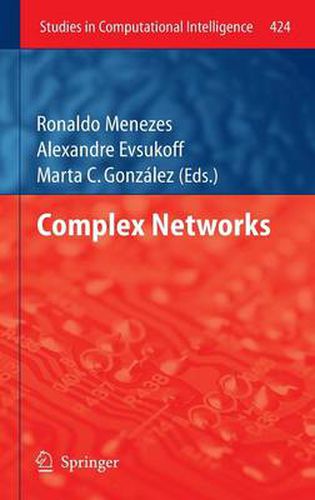Readings Newsletter
Become a Readings Member to make your shopping experience even easier.
Sign in or sign up for free!
You’re not far away from qualifying for FREE standard shipping within Australia
You’ve qualified for FREE standard shipping within Australia
The cart is loading…






This title is printed to order. This book may have been self-published. If so, we cannot guarantee the quality of the content. In the main most books will have gone through the editing process however some may not. We therefore suggest that you be aware of this before ordering this book. If in doubt check either the author or publisher’s details as we are unable to accept any returns unless they are faulty. Please contact us if you have any questions.
In the last decade we have seen the emergence of a new inter-disciplinary field concentrating on the understanding large networks which are dynamic, large, open, and have a structure that borders order and randomness. The field of Complex Networks has helped us better understand many complex phenomena such as spread of decease, protein interaction, social relationships, to name but a few.
The field of Complex Networks has received a major boost caused by the widespread availability of huge network data resources in the last years. One of the most surprising findings is that real networks behave very distinct from traditional assumptions of network theory. Traditionally, real networks were supposed to have a majority of nodes of about the same number of connections around an average. This is typically modeled by random graphs. But modern network research could show that the majority of nodes of real networks is very low connected, and, by contrast, there exists some nodes of very extreme connectivity (hubs).
The current theories coupled with the availability of data makes the field of Complex Networks (sometimes called Network Sciences) one of the most promising interdisciplinary disciplines of today. This sample of works in this book gives as a taste of what is in the horizon such controlling the dynamics of a network and in the network, using social interactions to improve urban planning, ranking in music, and the understanding knowledge transfer in influence networks.
$9.00 standard shipping within Australia
FREE standard shipping within Australia for orders over $100.00
Express & International shipping calculated at checkout
This title is printed to order. This book may have been self-published. If so, we cannot guarantee the quality of the content. In the main most books will have gone through the editing process however some may not. We therefore suggest that you be aware of this before ordering this book. If in doubt check either the author or publisher’s details as we are unable to accept any returns unless they are faulty. Please contact us if you have any questions.
In the last decade we have seen the emergence of a new inter-disciplinary field concentrating on the understanding large networks which are dynamic, large, open, and have a structure that borders order and randomness. The field of Complex Networks has helped us better understand many complex phenomena such as spread of decease, protein interaction, social relationships, to name but a few.
The field of Complex Networks has received a major boost caused by the widespread availability of huge network data resources in the last years. One of the most surprising findings is that real networks behave very distinct from traditional assumptions of network theory. Traditionally, real networks were supposed to have a majority of nodes of about the same number of connections around an average. This is typically modeled by random graphs. But modern network research could show that the majority of nodes of real networks is very low connected, and, by contrast, there exists some nodes of very extreme connectivity (hubs).
The current theories coupled with the availability of data makes the field of Complex Networks (sometimes called Network Sciences) one of the most promising interdisciplinary disciplines of today. This sample of works in this book gives as a taste of what is in the horizon such controlling the dynamics of a network and in the network, using social interactions to improve urban planning, ranking in music, and the understanding knowledge transfer in influence networks.